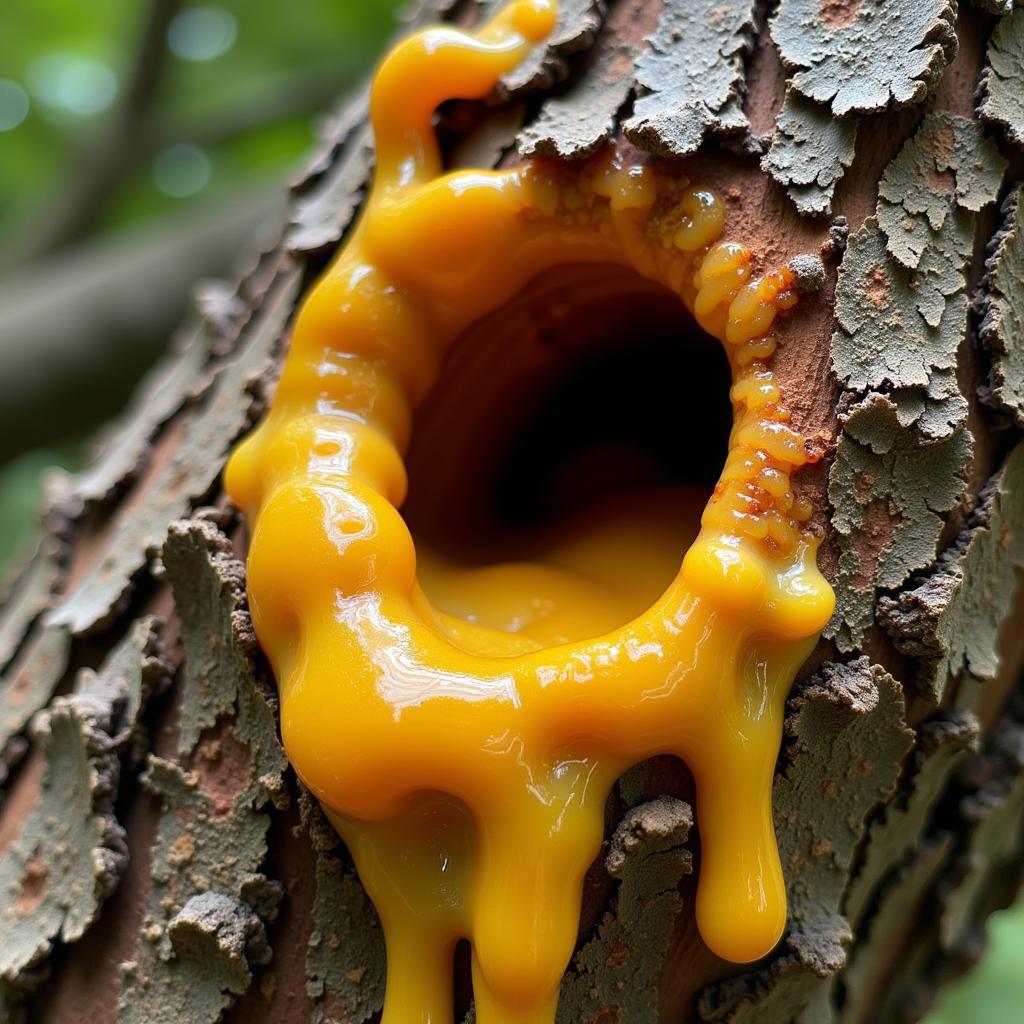Venetian Turpentine For Horses has a long history of use, primarily for hoof care. This article will explore the traditional applications of Venetian turpentine, its potential benefits and drawbacks, and important considerations for horse owners.
What is Venetian Turpentine?
Venetian turpentine, also known as larch turpentine, isn’t a true turpentine. Unlike turpentine derived from pine trees, Venetian turpentine is a resin obtained from the larch tree (Larix decidua). It’s a viscous, sticky substance with a yellowish-brown color and a distinctive aroma. Historically, it’s been used in various applications, including as a sealant, adhesive, and in some traditional medicinal practices. In the equine world, it’s most commonly associated with hoof care.
 Venetian Turpentine Resin from Larch Tree
Venetian Turpentine Resin from Larch Tree
Traditional Uses of Venetian Turpentine for Horses
Venetian turpentine is traditionally applied to horses’ hooves for several purported benefits. It’s often used to:
- Harden soft hooves: The resinous nature of Venetian turpentine is believed to help strengthen and harden the hoof wall.
- Treat thrush: Its antiseptic properties are thought to help combat thrush, a bacterial infection of the frog.
- Promote hoof growth: Some believe it stimulates hoof growth, although scientific evidence supporting this claim is limited.
- Seal hoof cracks: Venetian turpentine can act as a sealant, helping to prevent moisture and debris from entering hoof cracks.
Benefits and Drawbacks of Venetian Turpentine
While Venetian turpentine has its proponents, it’s crucial to understand both its potential benefits and drawbacks:
Potential Benefits:
- Natural remedy: For those seeking natural hoof care solutions, Venetian turpentine offers an alternative to synthetic products.
- Antiseptic properties: Its antiseptic qualities can be beneficial in treating thrush.
- Easy application: Applying Venetian turpentine is relatively straightforward.
Drawbacks:
- Limited scientific evidence: Many of the purported benefits lack robust scientific backing.
- Potential for allergic reactions: Some horses may experience allergic reactions to Venetian turpentine.
- Can trap moisture: While it can seal cracks, if applied incorrectly, it can also trap moisture, exacerbating hoof problems.
How to Apply Venetian Turpentine
If you choose to use Venetian turpentine, proper application is essential:
- Clean the hoof: Thoroughly clean and dry the horse’s hoof before applying Venetian turpentine.
- Apply a thin layer: Use a small brush or cotton swab to apply a thin layer of Venetian turpentine to the affected area.
- Avoid the coronary band: Do not apply Venetian turpentine to the coronary band, as it can irritate this sensitive area.
- Allow to dry: Allow the Venetian turpentine to dry completely before exposing the hoof to moisture.
Expert Opinion
“While Venetian turpentine has been used for centuries in hoof care, it’s important to remember that its efficacy isn’t fully understood,” says Dr. Emily Carter, DVM, Equine Veterinarian. “Always consult with your veterinarian before using Venetian turpentine, especially if your horse has any underlying hoof conditions.”
Conclusion
Venetian turpentine for horses can be a useful tool in certain hoof care situations, particularly for treating thrush or sealing minor cracks. However, it’s important to approach its use with caution, be mindful of potential drawbacks, and always consult your veterinarian for personalized advice. Understanding the facts about Venetian turpentine will help you make informed decisions regarding your horse’s hoof health.
FAQ
- Is Venetian turpentine safe for all horses? Not all horses tolerate Venetian turpentine, and some may experience allergic reactions.
- How often should I apply Venetian turpentine? Consult your veterinarian for specific guidance.
- Can Venetian turpentine cure all hoof problems? No, Venetian turpentine is not a cure-all for hoof issues.
- What should I do if my horse has an allergic reaction? Discontinue use immediately and contact your veterinarian.
- Where can I purchase Venetian turpentine? It’s available at some tack shops and online retailers.
- Are there alternatives to Venetian turpentine? Yes, several other hoof care products are available, including synthetic sealants and antifungal medications.
- Can I use Venetian turpentine on other animals? Consult a veterinarian before using Venetian turpentine on any animal other than a horse.
For further assistance, please contact us at Phone: 0772127271, Email: [email protected] or visit our location at QGM2+WX2, Vị Trung, Vị Thuỷ, Hậu Giang, Việt Nam. We have a 24/7 customer support team.